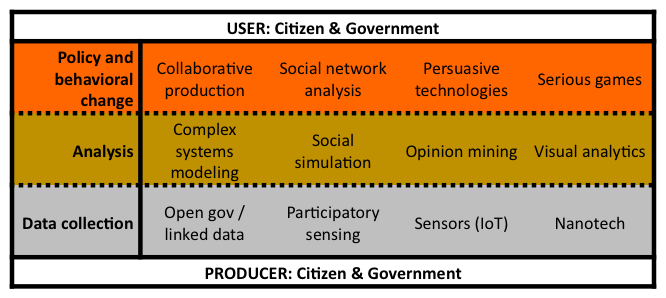The research challenges identified so far are not just a simple collection of research issues, but an integrated bundle of innovative solutions that together can lead to a paradigm shift in policy-making.
The CROSSROAD roadmap already identified an integrated approach based on a technology layer model with three layers: data, analysis and decision/action:
- The data layer provides new information that was previously not available.
- The analysis layer provides a new perspective and understanding of data.
- The behavioural change layer acts on the incentives and barriers to action and behaviour.
CROSSROAD’s Approach 
The CROSSOVER project refines this approach by linking each of the research challenge to a specific challenges in the framework, as described in section 3 and illustrated in the figure below.
To do so, we will go back in this section to the challenges and tasks of policy-making, as illustrated in section 3.
As we can see, the described research challenges capture all the main needs of policy-makers, and in particular the capacity to detect problems early and to leverage the collective intelligence in policy-making.
Figure 14: Relation Between Policy-Making Needs and Research Challenges
In view of this analysis, the next step is to relate each of the research challenges in the policy-making cycle. Each research challenge is in fact relevant for one or more of the specific tasks, not for all.
The figure below illustrates this relationship. In each of the phases of the cycle, for each of the tasks, we can identify the potential impact of the research challenges described.
The policy cycle starts with the
agenda setting phase, where the problem is identified and analyzed. In this section, visualization and opinion mining can help to identify the problems at an early stage. Advanced modelling techniques are then used to untangle the casual relationships behind the problem, understanding the causal roots that need to be addressed by policy.
Once the problem is clearly spelled out, we move to the
policy design phase, where collaborative solutions are useful to identify the widest range of options, by leveraging collective intelligence. In order to facilitate the choice of the most effective option, immersive simulations support decision-makers by taking into account unexpected impacts and relationships. Collaborative governance enables then to develop further and fine-tune the most effective option, for example through commentable documents.
Once the option is developed and adopted, we enter into
policy implementation. In this phase, it is crucial to ensure awareness, buy-in and collaboration from the widest range of stakeholders: social network analysis, crowdsourcing and serious gaming are useful to deliver this.
Already during this implementation, we move into the
monitoring and evaluation. Open data allow stakeholders and decision makers to better monitor execution; together with sentiment analysis, they can be used to evaluate the impact of the policy, also through advanced visualization techniques.
In summary, our vision for 2030 embodies a radically different context for policy-making 2.0.
On policy modelling and simulation, thanks to standardisation and reusability of models and tools, system thinking and modelling applied to policy impact assessment has become pervasive throughout government activities, and is no longer limited to high-profile regulation. Model building and simulation is carried out directly by the responsible civil servants, collaborating with different domain experts and colleagues from other departments. Visual dynamic interfaces allow users to directly manipulate the simulation parameters and the underlying model.
Policy modelling software becomes productized and engineered, and is delivered as-a-service, through the cloud, bundled with added-value services and multidisciplinary support including mathematical, physics, economic, social, policy and domain-specific scientific support.
Cloud-based interoperability standards ensure full reusability and composability of models across platforms and software.
System policy models are dynamically built, validated and adjusted taking into account massive dataset of heterogeneous data with different degrees of validity, including sensor-based structured data and citizens-generated unstructured opinions and comments. By integrating top-down and bottom-up agent based approaches, the models are able to better explain human behaviour and to anticipate possible tipping points and domino effects
On collaborative governance, policy-making leverages collective intelligence and collective action. It accounts for the
greater policentricity of our governance system. While traditional tools are designed for the public decision-makers, these research challenges are more
symmetric by nature, in order to engage stakeholders all through the phases of the policy-making cycle. Thanks to visualisation and design, it is able to reach out to new stakeholders and lower the barriers to entry in the policy discussions. Policy-making 2.0 is not only designed to be more effective, but also more participatory.
Next steps The present roadmap represents the starting point for collaboration. It will be published in commentable format for practitioners and researchers to comment and revise.
In particular, the present roadmap aiming to become a living platform, comments will be sought:
- From all stakeholders, on the relevance, clarity and completeness of the proposed research challenges
- From researchers, on the actual research carried out on these challenges
- From policy-makers, on the actual usage of these tools and methodologies, lessons learnt and challenges encountered
In addition, a dedicated survey of policy-makers on their needs and challenges will be carried out, in order to fine-tune the final roadmap to their needs.